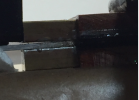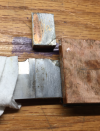- Joined
- Oct 29, 2015
- Messages
- 301
I agree with the others, I think you need a darker liner. Black would be the bees knees.
The BladeForums.com 2024 Traditional Knife is ready to order! See this thread for details:
https://www.bladeforums.com/threads/bladeforums-2024-traditional-knife.2003187/
Price is $300 $250 ea (shipped within CONUS). If you live outside the US, I will contact you after your order for extra shipping charges.
Order here: https://www.bladeforums.com/help/2024-traditional/ - Order as many as you like, we have plenty.
Wow Stacy ... that is pretty harsh. This is for my own use, and I am ok with 1/8” pins. Part of the hurry is other knives I need to attend to . The other part is that this is my only bread knife ... and I kind of need it back in serviceI'm interested in seeing if those bolsters stay on when you go to shape them. Soldering alone is pretty weak. I would drill two holes with a carbide bit and put in brass rivets.
I agree with the others that the pink liner is wrong. Use a dark red or black.
Not opening up the holes because you don't want to "take the time" is a poor excuse for not doing it right.
I told you guys I am esthetically challenged. Black it is then!I agree with the others, I think you need a darker liner. Black would be the bees knees.
ok Stacy - here you go (sorry for the delay in continuing this - hard to get time in the shop these days. You did not even need to wait until shaping the bolsters: this happened just now while I was gluing on the second scale, and cinching the scale up to the bolster lengthwise using a clamp:I'm interested in seeing if those bolsters stay on when you go to shape them. Soldering alone is pretty weak. I would drill two holes with a carbide bit and put in brass rivets.
I agree with the others that the pink liner is wrong. Use a dark red or black.
Not opening up the holes because you don't want to "take the time" is a poor excuse for not doing it right.


Hmmm. I used a paste flux made by Harris. I bought it as part of a silver soldering kit sold by (one of the major knifemaking suppliers - name edited out). I assumed compatibility as they sold it as a set. Was that a bad assumption?If you used rosin or paste flux used for plumbing work, that was the problem. The solders we use for attaching bolsters and guards are a silver bearing solder,. TIX is the best IMHO. You need the flux that is the mate to the solder used. It is a thin liquid usually.
Oh ... my mistake. Said rosin when i*meant* flux. I do know the difference. Too many years soldering electronics I guess....If it was the flux that came with it, it should have been OK. When you called it rosin, I was concerned that you used plumbing or electronics flux.
There are a lot of things that can go wrong in soldering. Too much heat is number one. It destroys the flux and makes the joint refuse to flow. It takes a very small torch and flame to solder guards and bolsters correctly. Many people use a plumbers propane torch, which is about 100 times more powerful than needed.
Yeah, I have read that. Tell the truth though, that approach kind of goes against the grain for me. In a good joint, the solder should wick in - otherwise the bond to the metal is not there. Clearly that did not happen in this case ... I’ve got no idea why (it’s literally been decades since I have produced a bad solder joint of any kind. I hope this is not an indicator of things to comeI've seen a lot of folks use pieces of solder that they have smashed flat, put in the joint, then applied pressure with a clamp, and applied a torch to it. That way the solder is already in place and you don't have to worry so much about whether you got complete coverage.

